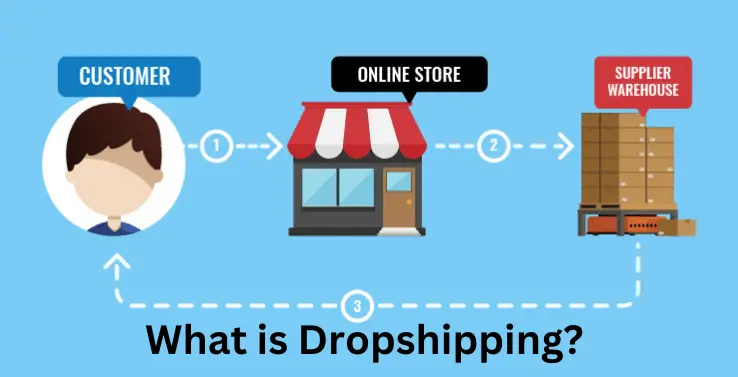Dropshipping vs Affiliate Marketing: Are you looking to start a business online, then dropshipping and affiliate marketing are the first few things that come to your mind. While these two concepts may seem similar, they have distinct advantages and disadvantages. So, it’s crucial to select the appropriate business model that meets your needs.
In this article, we’ll explore dropshipping vs affiliate marketing and help you determine which one is the right choice for you.
Dropshipping vs Affiliate Marketing
If you’re exploring ways to make money online, you may have come across dropshipping and affiliate marketing. While these two concepts may appear similar, there is a fundamental difference between them – the point of sale.
In affiliate marketing, the affiliate directs traffic to the merchant, who then handles the sale. On the other hand, with dropshipping, the dropshipper manages the sale and then forwards it to the merchant for shipping. From this, affiliate marketing seems effortless when you can make money while sleeping but a dropshipper has to do more effort.
What is Dropshipping?

The dropshipper takes care of marketing and sales, while the manufacturer handles product shipping. To grow their audience and generate interest in their products, dropshippers use various digital marketing tools, including SEO, Facebook and Google ads, content marketing, and videos.
Unlike affiliate marketing, dropshippers set their own prices for each product, and they earn their profits from the difference between the product’s wholesale price and the sale price. Here’s how it works:
- The dropshipper and manufacturer agree on a partnership.
- The dropshipper sets the prices for the products they want to sell.
- Customers visit the dropshipper’s website and make a purchase.
- The dropshipper receives all proceeds from the sale.
- The dropshipper buys the product from the manufacturer at a wholesale price.
- The manufacturer ships the product to the customer.
- The dropshipper earns their profits from the sale, minus the wholesale price paid to the manufacturer.
For instance, suppose you’re a manufacturer selling hand-made wine racks. As a dropshipper, I would build a user-friendly website, establish my brand, and use e-commerce capabilities to sell your wine racks. Let’s say I sell your premium wine rack model for $200. When a customer buys it on my website, I would forward the order to you, along with $50 to buy the product at a wholesale cost. You would then ship the wine rack to the customer, and I would make a $150 profit, while you earn $50.
Essentially, a dropshipping website is just like an e-commerce store, with the only difference being that dropshippers don’t need to hold stock. The key advantage is that dropshippers have more control over their pricing and branding, while the manufacturer focuses on product quality and shipping.
What is Affiliate Marketing?

When it comes to comparing dropshipping with affiliate marketing, it’s important to understand what affiliate marketing is all about.
Affiliate marketing is a type of online marketing in which an affiliate promotes a merchant’s product or service through unique affiliate links. The affiliate earns a commission for each sale that is generated through their links.
To get started with affiliate marketing, a merchant must create an affiliate program using software. Affiliates can then sign up for the program and start promoting the merchant’s products.
Unlike dropshipping, the affiliate is not responsible for the sales process. Their goal is to simply drive traffic to the merchant’s website and encourage customers to make a purchase. When a customer makes a purchase through the affiliate’s link, the merchant pays out a commission to the affiliate.
For example, let’s say you sell hand-made wine racks and have an affiliate program set up. As an affiliate, my job would be to use my marketing skills to drive traffic to your website. If someone clicks on my affiliate link and makes a purchase, I would earn a commission on that sale.
The commission rate varies depending on the merchant and the product being sold. It’s up to the affiliate to find the right products to promote and effectively market them to their audience.
In summary, while dropshipping requires the dropshipper to handle marketing, sales, and order fulfillment, affiliate marketing only requires the affiliate to promote the merchant’s product and drive traffic to their website. It’s a different approach to earning passive income, but it can be equally effective when done right.
Discover the Pros and Cons of Dropshipping
When it comes to dropshipping and affiliate marketing, both have their advantages and disadvantages. Understanding the benefits and drawbacks of each can help you decide which business model is right for you.
The upsides and downsides of dropshipping will also depend on your position in the supply chain, whether you’re a manufacturer, merchant, or entrepreneur. So, who exactly benefits from dropshipping, and what are the key advantages and disadvantages?
Pros of Dropshipping
If you thinking of starting an online business but don’t want to deal with the hassle of managing inventory? Then dropshipping might be the perfect solution for you.
One of the biggest advantages of dropshipping is its low start-up cost. You don’t have to worry about stocking inventory or investing in a warehouse to store your products. Instead, you work with a supplier who ships the products directly to your customers. This means you can focus on growing your business and driving sales.
Additionally, dropshipping allows you to offer a wide variety of products without the need to purchase inventory upfront. You only pay for the products when you receive payment from the customer, which means you can operate with minimal financial risk.
All you need is a well built ecommerce store which can be made with a very little investment now a days.
Another major advantage of dropshipping is the freedom it gives you to set your own prices and margins. You can determine how much profit you want to make and adjust your pricing accordingly. You also have the ability to customize the products you sell and make them feel like your own brand.
While there may be a learning curve for beginners, dropshipping has very few barriers to entry. This makes it an attractive option for anyone looking to start an online business without a significant investment. Just remember that your success ultimately depends on your ability to market your store and deliver a positive customer experience.
Cons of Dropshipping
When it comes to dropshipping, there are some downsides that you should consider before getting started. One of the most significant cons is the responsibility for making sales.
Generating sales can be a challenging task, and it requires constant optimization of your marketing strategies to achieve success. You’ll also have to invest in building your brand to stand out from the competition.
Another potential drawback of dropshipping is that you’re responsible for customer support. This means that you’ll have to handle any customer issues that arise, even though you have no control over product quality or shipping times, which are common complaints.
Failing to address these issues can harm your brand’s reputation, and resolving them demands additional resources. If your focus is solely on marketing and sales, customer support may not be your forte, making this aspect a disadvantage.
Despite these cons, this business model remains an attractive option for entrepreneurs looking to start with limited resources. However, it’s essential to consider both the pros and cons before you start.
Discover the Pros and Cons of Affiliate Marketing
While there are similarities between affiliate marketing and dropshipping, the cons are slightly different.
Pros of Affiliate Marketing
One of the major advantages of affiliate marketing is that it’s easy to get started. Unlike dropshipping, you don’t need to invest in stock or warehousing. Plus, you don’t need an e-commerce store to start. You can begin affiliate marketing using your social media profiles, YouTube channel, or a marketing website.
If you can build an audience, then you’ve got a good opportunity to monetize what you’re doing through affiliate marketing. It’s a low-risk business model that you can get started with immediately. Existing e-commerce stores find it attractive because it’s low-risk. Your only investment is in affiliate marketing software, which should not cost you more than $300 per year.
With this, you can mobilize an army of affiliates and influencers to promote your products and expand your reach. You don’t pay affiliate commissions until the sale has been approved, so there’s a lot of upside without having to make any big investments.
Cons of Affiliate Marketing
The downside of affiliate marketing is that affiliates don’t have a lot of control. They rely on the merchant to maintain their brand image, make sales, and invest in their affiliate program. If any of these things stop, it will have a negative impact on an affiliate’s income.
The good news is that there are an endless number of affiliate networks and programs out there. However, sometimes there’s a lack of consistency. Unlike dropshipping, there tends to be more variety of offers in affiliate marketing. For merchants, finding the right affiliates can be challenging, but innovative affiliate software makes this a little bit easier.
Affiliate marketing is a lucrative business model that’s easy to start, has a low risk, and can be highly profitable. While there are downsides, affiliate marketing remains an excellent way to earn passive income. Whether you’re an aspiring entrepreneur or an established business, affiliate marketing can be an excellent addition to your online revenue stream.
Read also:
- Clickfunnels vs Shopify 2023 | Which One Is The Best?
- Hostinger Review (2023): Pros & cons
- Social Media Marketing in 2023: The Complete Guide for Businesses
- 7 Profitable Niches to Work on Fiverr
Dropshipping vs Affiliate Marketing: Which One is Perfect for You?
If you are hesitant to choose between affiliate marketing and dropshipping, the decision largely depends on your goals and what you’re looking to achieve.
For manufacturers, dropshipping is a popular option as it offers a cost-effective way to get their products into the hands of customers. Meanwhile, merchants typically find that affiliate marketing is the best choice because it allows them to retain control over their brand without eating into their profits.
But if you’re just starting out in the online business world, you don’t have to choose between the two just yet. Affiliate marketing can be an easier way to get started, allowing you to focus on honing your marketing skills and earning money while you do so.
As you gain experience and knowledge, you can start to add e-commerce capabilities and explore dropshipping as an option. Combining the two models can also work well, as many small businesses have found success doing so.
With an affiliate website as your starting point, you can learn about digital marketing, grow your website, and eventually turn it into a profitable e-commerce business. So whether you choose affiliate marketing, dropshipping, or both, there’s no reason why you can’t achieve your online business goals.









